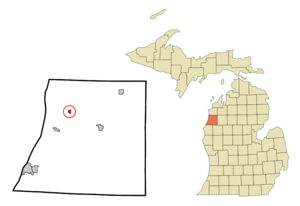- Bear Lake, Michigan
Infobox Settlement
official_name = Bear Lake, Michigan
settlement_type = Village
nickname =
motto =
imagesize =
image_caption =
image_
imagesize =
image_caption =
image_
mapsize = 250px
map_caption = Location of Bear Lake in Manistee County, Michigan
mapsize1 =
map_caption1 =subdivision_type = Country
subdivision_name =United States
subdivision_type1 = State
subdivision_name1 =Michigan
subdivision_type2 = County
subdivision_name2 = Manisteegovernment_footnotes =
government_type =
leader_title =
leader_name =
leader_title1 =
leader_name1 =
established_title =
established_date =area_footnotes =
area_magnitude =
area_total_km2 = 0.9
area_land_km2 = 0.8
area_water_km2 = 0.0
area_total_sq_mi = 0.3
area_land_sq_mi = 0.3
area_water_sq_mi = 0.0population_as_of = 2000
population_footnotes =
population_total = 318
population_density_km2 = 390.4
population_density_sq_mi = 1011.1timezone = Eastern (EST)
utc_offset = -5
timezone_DST = EDT
utc_offset_DST = -4
elevation_footnotes =
elevation_m = 241
elevation_ft = 791
latd = 44 |latm = 25 |lats = 19 |latNS = N
longd = 86 |longm = 8 |longs = 49 |longEW = Wpostal_code_type =
ZIP code
postal_code = 49614
area_code = 231
blank_name = FIPS code
blank_info = 26-06460GR|2
blank1_name = GNIS feature ID
blank1_info = 0620870 [gnis|0620870]
website =
footnotes =Bear Lake is a village in Manistee County of the
U.S. state ofMichigan . As of the 2000 census, the village population was 318. The village is located within Bear Lake Township.Geography
According to the
United States Census Bureau , the village has a total area of 0.3square mile s (0.9km² ), of which, 0.3 square miles (0.8 km²) of it is land and 0.04 square miles (0.1 km²) of it (6.06%) is water.Demographics
As of the
census GR|2 of 2000, there were 318 people, 132 households, and 85 families residing in the village. Thepopulation density was 1,011.1 per square mile (396.1/km²). There were 161 housing units at an average density of 511.9/sq mi (200.5/km²). The racial makeup of the village was 93.71% White, 1.89% Native American, 2.52% Asian, 0.31% from other races, and 1.57% from two or more races. Hispanic or Latino of any race were 4.72% of the population.There were 132 households out of which 30.3% had children under the age of 18 living with them, 51.5% were married couples living together, 8.3% had a female householder with no husband present, and 35.6% were non-families. 32.6% of all households were made up of individuals and 18.9% had someone living alone who was 65 years of age or older. The average household size was 2.41 and the average family size was 2.99.
In the village the population was spread out with 26.4% under the age of 18, 7.2% from 18 to 24, 25.2% from 25 to 44, 21.4% from 45 to 64, and 19.8% who were 65 years of age or older. The median age was 39 years. For every 100 females there were 101.3 males. For every 100 females age 18 and over, there were 90.2 males.
The median income for a household in the village was $31,389, and the median income for a family was $35,139. Males had a median income of $30,000 versus $22,083 for females. The
per capita income for the village was $15,170. About 9.2% of families and 12.7% of the population were below thepoverty line , including 25.0% of those under age 18 and 8.3% of those age 65 or over.History
Bear Lake grew as a typical lumber boom town during the late 1800s.
The first settlers arrived around 1863, primarily in search of free land, after President Lincoln signed the
Homestead Act in 1862. The settlers found the land full of virgin forest of white pine and hardwoods. Homesteaders were forced to cut and burn the trees in order to have land to farm.In 1867, one of the first homesteaders, Russell Smith, platted out the original village of Bear Lake, offering free land to any person who would open a saw mill there. Within a few years, lumber became big business in Bear Lake. The boom hit soon after 1873, when brothers George W. and David H. Hopkins, purchased the land in the village, and proceeded to build a large sawmill, a brickyard, a
gristmill , a store, and the first and only railroad to serve the village. The railroad stretched from Bear Lake west to the Lake Michigan shore at Pierport and west nearly as far as Kaleva.The village of Bear Lake was incorporated in the fall of 1893 by action of the Board of Supervisors of Manistee County.
By 1903, all of the trees in the area had been cut. The railway was taken away for use in Florida. [Merrill, Uledene. Railroad that Disappeared. Clarke Historical Library, Central Michigan University Term Paper, 1957. (Manistee)] . Industry shifted to predominantly agriculture, and later, summer tourism. At one time, the population of the village was near 1,000. As of the 2000 census,it stands around 300.
chool System
Bear Lake currently has a K-12 public school . Bear Lake is one of the schools given the
Freedom to Learn grant giving students and teachers use of modern technology such as laptops for use in the classroom. Teachers in this school are helping other teachers across the state with these learning tools.The Bear Lake Schools district covers most of both Pleasanton Township and Bear Lake Township.
Business and industry
The Bear Lake area is the home to various business and industry; primarily agriculture focusing on fruit production, and tourism due to the lake and the adjacent
Manistee National Forest andPere Marquette State Forest .Bear Lake has oil and natural gas resources. Since the 1970s, various successful projects have produced significant quantities of both.
Further reading
* [http://clarke.cmich.edu/localhistory/Manistee.htm Clarke Historical Library, Central, Michigan University, Bibliography for Manistee County.]
*Merriman, William. History of Bear Lake 1863-1950. Clarke Historical Library, Central Michigan University Term Paper, 1973.References
External links
* [http://www.bearlakemichigan.org/ Village of Bear Lake, Michigan]
* [http://www.worldoil.com/magazine/MAGAZINE_DETAIL.asp?ART_ID=2456&MONTH_YEAR=Dec-2004 Oil and Gas in Bear Lake Village]
Wikimedia Foundation. 2010.


